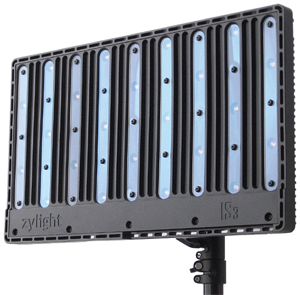Zylight IS3 Intelligent LED Light

The Zylight IS3 Intelligent LED fixture
Zylight does it again with its new intelligent LED Light, the IS3. Just as with everything else Zylight does in the LED world, the new IS3 is dimmable and has an adjustable color temperature to allow users to mix both daylight and tungsten light. It’s also wirelessly remote-controllable.
FEATURES
The IS3 is much larger and more powerful than anything else in Zylight’s arsenal. What amazes me most is how versatile this light is with all of its features. The front of this heavy (13 pound) unit is comprised of a bank of 22 light emitting diodes (LEDs). Each four-color lighting module is bright and powerful. Unlike any other LED unit I’ve used in the past, the IS3 also sports an optional softbox that attaches to the front via six metal poles and dramatically softens the light’s output.
The rear of the IS3 is where most of the versatility comes into play. Mounting to your C-stand with a Kino-Flo type adapter, you can pivot the Zylight in a multitude of angles. There’s a rocker switch that allows choices between white and colored light, and a dial for selecting color temperature and displaying that number in degrees Kelvin.
Another knob adjusts plus or minus green color correction, and there’s yet another dial for adjusting LED intensity from zero to a maximum of 100 with no color shift (a feature something that makes LED lighting instruments unique). Switching the toggle to “color” changes your output to unlimited color control. There are also two presets for both color and white modes.

The Zylight IS3 in use Most of the rear of the IS3 fixture is a massive heat sink for removing excessive warmth. While the front Low power consumption, panel stays cool, the rear is often warm to the touch.
The unit’s AC power supply converts line voltage to 48 VDC. The 220 Watt IS3 will function for a minimum of 50,000 hours before Zylight recommends re-calibration. A rechargeable battery is also available; however, I did not test that in this evaluation.
And with Zylight’s Zylink you can wirelessly control several Zylights at the same time with each instrument mirroring adjustments made.
IN USE
My demo IS3 arrived in a large Pelican case and was put to use immediately in our school’s TV studio. According to Zylight, the unit is four times brighter than other LED fixtures and I aimed to see if that statement were indeed a fact. I’ve always enjoyed the ability to mix color temperatures in shooting in order to cope with differing flesh tones (no one seems to have the one “correct” skin tone). Pure tungsten and daylight sources are never right. Mixing other LED units by eyeball is not accurate and you have to guess if you need to add a little more warmth or coolness to the shot. Not so with the IS3—you have an LED readout of the exact color temperature in degrees Kelvin so you can set your camera accordingly. The new plus or minus green color correction also helps when working with other lights that may not be as accurate as the IS3.

The unit’s color control, if switched to color, is useful if you want the green glow of an offset fluorescent, or the blue cast of moonlight. (I would only use this feature if adding such an effect was the sole purpose of the LED fixture and I had another light source as my key.)
In recording a studio interview, I used the IS3 as my key and fill illumination by placing it almost directly in front of my subject. Most LED units do not have the throw or output of a tungsten unit or a more powerful HMI. However, the IS3 surprised me. At a distance of five feet, I had to dim the light to 65.5 percent and I still shot with an f-6.3 lens opening. I have never had an LED that could provide that amount of light output without considerable falloff.
The IS3 appears to be a 16:9 aspect ratio light in that it’s shaped more like a widescreen fixture than one intended for standard-definition’s 4:3 aspect ratio. It provides a much wider pattern of illumination than other LED units.
Using the softbox helped soften the quality of light and forced me to up the intensity to 100 percent. Due to my subject’s blonde hair and light skin tone, I adjusted the color temperature almost to daylight (5,595 degrees K) and balanced the camera for daylight. This cool color temperature was more suited for the hair and skin tones than if I’d added in more tungsten. With the instrument’s adjustment range spanning a very warm 2,500 degrees K down to an ice-cold 15,000 degrees K, I doubt that you would run into any situation where the correct color temperature wouldn’t be available.
The only time I found the softbox necessary was when I wanted the light very close to the talent to bring out eye sparkle, and didn’t want to blind the person with too much light. Again, the IS3 is extremely bright for an LED unit.
SUMMARY
There is very little this light can’t do. It’s bright, versatile, and is more than enough illumination for close and personal work without the heat of conventional lighting. At 13 pounds, this is a very heavy light, and I’m not too fond of the mounting system. But if you need something like this and won’t be moving it around constantly—you’ll certainly get a lot of bang from your buck.
Chuck Gloman is program director of the TV/Film Department as well as a member of the faculty of DeSales University. He may be contacted atchuck.gloman@desales.edu.
Get the TV Tech Newsletter
The professional video industry's #1 source for news, trends and product and tech information. Sign up below.
Chuck Gloman is Associate Professor with the TV/Film Department at DeSales University.

